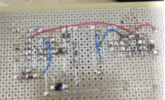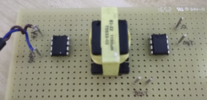I have a design based on Luden's design which you can refer to at
https://ludens.cl/Electron/esr/esr.html
Why I chose this design? It is conceptually simple, and technically sound. One might be turn off by the use of transformer, but it is needed because the of impedance transformation to ensure that the output of the Op amp is terminated correctly to maximise power transfer of the 100Khz oscillation. Of course there are other means to do that like having a parallel banks of driver with 74HC14 to drive the oscillator output in some other design.
There are a number of modifications to the original design.
1. Created a virtual ground with a stronger drive
2. Change oscillator frequency to 100Khz
3. Change the ferrite transformer to 10:1 instead of the 20:1
4. Change load impedance for measurement to 5 ohms
5. Use 12V instead of 9V
6. Use a simple peak detector instead of the voltage doubler design
7. Use a buffer for the 500uA meter
Rationale for the change
1. The drive for virtual ground needs to be stronger because it need to drive the transformer input otherwise the virtual ground may noisy when the drive is too strong
2. 100Khz is better than 50Khz
3. 10:1 transformer is widely available by extracting the ferrite transformer of a flyback DC-DC (230V to 5V). This transformer will give you approximately 10:1. However, I must state than 20:1 is a better ratio, because the reflected impedance to the Op will be 400*RL (load impedance). With 10:1 the reflected impedance is 100*RL
4. The original load impedance when test points are shorted in 10//10 = 5 ohms. But I have it changed to 10//5 = 3.33 ohms. So the original reflected impedance with 20:1 transformer = 400*5 = 2000 ohms, but the modified one will be 100*3.33 = 333 ohms. Peak AC current with 6Vpp output = 3 /333 = 9 mA p-p which is supportable by TL082 op amp.
5. The luden design uses 5V (9V via 5V regulator). This is mistake in the original design, because the TL062 use in the original design require at least 5V for each rail, meaning 10V minimum is needed for + and - rail. I have use TL082 which has slightly lower requirement, but I think 10V is still too low. In the datasheet, for +/-15V rail, the guaranteed swing is +/-12V which means there is an inherent lost of 3V on each rail. This means that at +6 and 6, the max swing allowed in +3V and -3V. So, I have to bear this in mind, when I use 12V. High voltage will be
better, but I stick to 12V because this DC-DC power is widely available.
6. A voltage doubler does not give much benefit because if the amplifier is allow a swing of +3V to -3V, doubling the voltage to 6V would have a swing exceeding 3V. A simple peak detector will ensure that the swing is less than what the earlier amplifier stage level input. There will be a voltage loss due to the forward voltage on the diode but that is about 0.3V when using a schottky diode which is tolerable.
7. A buffer amplifier is used to drive the ammeter because I cannot get a 50uA meter, and I want to use a cheap multimeter which already has a ohm range dial plate with scale I can use directly. The cheap multimeter is a 500uA type, so I need a low impedance source via a op amp buffer to provide a stronger drive. Note also that the gain-bandwidth product of TL082 is at 4Mhz, so I have to moderate the gain to ensure that Gain-BW product is not exceeded, max gain = 4000/100 = 40 max, but I use 10 which it think is already too high. Ideally, we should have a margin of 10, but I don't have a choice unless I use a better op-amp. This is quite obvious from the observed waveform after amplification with rounded edge where the high frequency harmonics are reduced. Hopefully, this does not cause too much errors. The original Luden's design also has this problem. With TL062, Gain-BW is 1Mhz, with 50Khz oscillation, max gain = 1000/50 = 20, and yet Luden's design is using a gain of 39. ???. So if you are using Luden's design, please use at least TL082 instead of TL062.
The schematic is attached for anyone who wants to build it.
The ESR meter was build on vero board and pending arrival of the meter
Test:
1. Shorted lead - output = 2.38V
2. With 10 ohms = 0.838V
This is very close to expectation since with 10 ohms, the voltage will be at 1/3 level when it is shorted.
Meaning at 5 Ohm, will be 50% deflection, 10 ohm will be 33% deflection on the meter.
The ESR was build with SMD components so it's all on the copper side. Transformer and TL082 op amp are seen on the top side.






